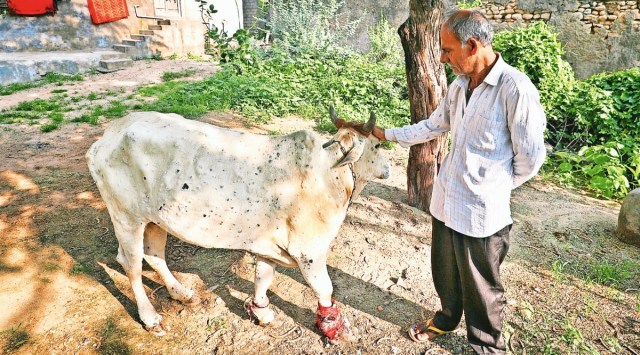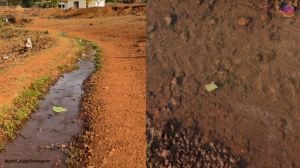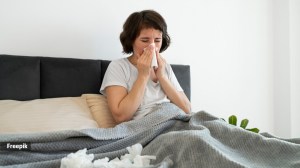- India
- International
Kutch emerges epicentre of Gujarat’s Lumpy Skin disease outbreak, records more than half the toll
Trenches and bloating cattle carcasses on the pastoral land adjoining the Mundra-Mandvi coastal highway, suggest high casualty numbers. Dogs feed on the carcasses, while black drongos and cattle egrets feast on flies swarming the remains.
 Babubha Jadeja, 55, is making desperate attempts to save
his cow , Kajal, from the viral disease. Nirmal Harindran
Babubha Jadeja, 55, is making desperate attempts to save
his cow , Kajal, from the viral disease. Nirmal HarindranIn early July, Altaf Bafan (26), a cattle-herder of Bhujpur village in Kutch, used to take around 450 cows owned by various residents of Bhujpur out for grazing for a fee. Now, his herd has shrunk after at least 100 cows died of Lumpy Skin Disease (LSD). Two of them died on Hadakudi pasture, where he used to take the cattle for grazing. The pasture has now turned into a cattle graveyard.
“It has turned into a ghostly place with so many cows buried there,” says Bafan who gets Rs 150 per cattle head per month from their owners. “It is so painful to watch the cows suffer this way. It is the houseflies that killed most of these cows,” he adds.
Trenches and bloating cattle carcasses on the pastoral land adjoining the Mundra-Mandvi coastal highway, suggest high casualty numbers. Dogs feed on the carcasses, while black drongos and cattle egrets feast on flies swarming the remains.
“Heavy rain prevented vehicles from ferrying the carcasses to the land… Therefore, those providing carcass disposal services as well as cattle owners started dumping them on the roadside. We had to dig trenches to bury the carcasses,” says Bhimji Nanjar, husband of Bhujpur sarpanch Laxmi.
The viral disease that originated in Africa has been sweeping Gujarat for three months since the first case was reported on April 23 in Kaiyari village in Abdasa taluka of Kutch district, where many depend on cattle-herding for their livelihood.

The border district, with livestock population of around 23.79 lakh, has been the worst affected district, accounting for 38,891 cases or 52 per cent of the total reported cases in the state as of August 10. It also accounts for 1,835 deaths, more than half of the state, which has reported 2,782 deaths till Wednesday.
In Gujarat, the infection has spread in 23 districts and the state government had issued orders on July 28, declaring 14 districts as “controlled districts” prohibiting transportation of cattle and conducting cattle fair.
The fear that bloating carcasses would spread disease, led to dramatic scenes in Gandhidham on July 27 as the LSD spread to eastern part of the Kutch after ravaging Mundra, Mandvi, Lakhpat, Nakhtrana, Bhuj and other talukas in West Kutch, when residents of Sathvara Colony in Sector 5 forced a tractor loaded with cow carcasses to return to the headquarters of Gandhidham municipality.
“They were dumping carcasses in bushes behind the ground where the Saturday weekly market is held. Dogs would drag parts of carcasses to streets in our locality. We had no other option but to protest,” says Raju Sathvara, who runs a cold drinks outlet on Ambedkar Road.
Deendayal Port Authority, which runs the largest port at Kandla, allowed the municipality to bury carcasses in an open plot near the sewage treatment plant. Four tractors of the municipality loaded with carcasses, have been making trips to this ground from the town as well as Kamdhenu Gaushala on the ourtskirts of Adipur.
“Around 600 cattle deaths were reported in the town due to LSD till now though the number of daily casualty has gone down now,” Darshansinh Chavda, chief officer of the municipality says, adding, “The actual number of carcasses being disposed of in our facility could be high as we are allowing nearby village panchayats also to use it.”
In Moti Bhujpur village of Mundra taluka, a six-month-old Kankrej female calf tries to unsuccessfully ward off houseflies from the ulcers on its feet at an enclosure belonging to Viruba Jadeja in Darbar Faliya. The calf has been battling for its life for the past two weeks after its mother and another of Viruba’s cows died of LSD.
“I had gone to my parent’s home, leaving my two cows with a local cattle-herder for grazing. When I returned after two days, both of them had been taken away by sansthawala, an NGO, for treatment after they developed LSD… both died,” says Viruba, 65, adding, “How will I raise this calf now?”
Viruba has lost her husband and her son Jalubha is a casual labourer. Her neighbour Babubha Jadeja, 55, is also making desperate attempts to save his cow , Kajal, from the viral disease.
In the neighbourhood, Pratipalsinh Vaghela (17) is perspiring profusely as he tries to push bags filled with chaff against his cow who suffers seizures.
“This cow used to give us six litres of milk daily but it contracted LSD a month ago and has been ill since. Her one-month-old calf succumbed a few days ago. She collapsed last night,” says the Class 12 student whose father is a crane operator.
In a street in the same locality, Vinod Nanjar, a casual labourer, strokes his cow that has lumps and sores all over. “I lost two cows to LSD and this is the only one surviving. But there are too many houseflies at our home, so we are keeping this one on the street for some respite,” he says.
Sitting inside a paan shop at the entrance of the village, Mahobatsinh Jadeja looks listless. He lost six of his eight cows in five days, three of which were lactating.
“ I am ruined,” says the father of four, who earned Rs 10,000 a month by selling milk.
Madhubha Jadeja, 62, a casual labourer, says the last month of LSD has brought back memories of the “brutal second wave of Covid-19”.
“My cow and her one month-old calf contracted LSD… The calf died and the mother stopped giving milk. The veterinarian told me, just like Covid-19, there is no sure shot treatment for LSD,” he says.
Villagers say LSD, which is spread by blood-sucking vectors such as flies, mosquitos and ticks, hit the village like a storm. “Cases first appeared in Bhujpur Panglapol, then among cattle in the village and evenutally among the livestock on farms,” says Naran Gilva, a Bhujpur resident who works for Madhav Gauseva Samiti, which works for cattle welfare and ran an isolation centre for infected cows from July 21 to August 3.
Panglapol is a charitable organisation that takes care of 4,700 abandoned and unproductive cattle. “The animals we had were unproductive and weak and therefore susceptible to disease. Around 600 of our cattle were infected by LSD and despite our best efforts, around 300 died. Now, the daily casualty has come down to five from 20,” says a trustee of the Panglapol, requesting anonymity.
Haresh Patel, livestock inspector at First Aid Veterinary Centre run by the Kutch district panchayat in Bhujpur, says the infections peaked between July 10 and 25 and that the worst is over. “There has been no fresh infections for a week now. However, infected cattle are still battling the infection,” he says.
On record, the village reported 150 LSD cases. “But not every cattle owner may be reporting the infection among their livestock to us and therefore, the actual number of cases and fatalities may be higher,” says the inspector.
Newsletter | Click to get the day’s best explainers in your inbox
Kutch district has a total livestock population of 23.79 lakh of which 38,957 were infected till Wednesday across 626 villages in 10 talukas. Vaccination has covered 3,97,193 cattle so far, according to government figures.
Hardik Joshi, a veterinarian with Kamdhenu Gaushala, has been performing various surgeries, including amputation of infected legs, on cows and bulls in an attempt to save their lives after contracting LSD.
“Cattle can live on three legs. So, as last resort, we are performing amputation if the ulcers and infections don’t heal despite antibiotics,” says Joshi.
Haresh Thakkar, deputy director of animal husbandry in Kutch, says the morbidity and mortality among stray cattle in urban areas are high. “This is primarily because, these animals are already in immune-compromised stage due to eating plastic. As they are weak, they don’t respond to treatment as other normal cattle,” says Thakkar, insisting government is not underreporting cases.
“We have directed panchayats to report the cases through nodal officers that we have appointed in every taluka. But it is possible that some cattle-owners may prefer to treat their cattle on their own and not report the cases to the government,” he adds.
Apr 26: Latest News
- 01
- 02
- 03
- 04
- 05








































